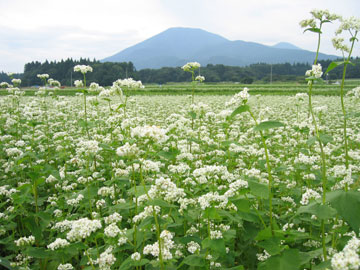Buckwheat (Soba noodle) history
 Buckwheat is widely grown around the world because it can grow even in rough terrain with harsh weather conditions.
It has also been eaten in Japan since ancient times.
Nagano is famous as a buchwheat production area because its cold climate and nutrient-poor soil have nurtured high-quality buckwheat.
Buckwheat is widely grown around the world because it can grow even in rough terrain with harsh weather conditions.
It has also been eaten in Japan since ancient times.
Nagano is famous as a buchwheat production area because its cold climate and nutrient-poor soil have nurtured high-quality buckwheat.
Buckwheat is usually eaten in crepe or paste form, but Japan has its own unique way of eating buckwheat in noodle form. This is called "soba-kiri," and has been popular since the Edo era.
In literature, buckwheat noodles (soba) are mentioned as a specialty of Motoyamajuku on the Nakayama Expressway. It was introduced to Edo as a quick and easy way to eat soba, and was favored by the common people of Edo as fast food at food stalls, and eventually spread throughout Japan.
Meanwhile, during the Edo era, when the shogunate ordered the feudal lords to relocate to different parts of the country, soba chefs from Shinshu (present Nagano prefecture) were brought with them, and famous soba restaurants sprang up all over the country.
Particularly famous are "Izumo soba" in the Izumo region of Shimane Prefecture, "Izushi soba" in Toyooka City, Hyogo Prefecture, and "Aizu soba" in the Aizu region of Fukushima Prefecture. All of these types of soba were introduced to Japan by the feudal lords of Shinshu when they moved to another part of Japan.
The Roots of Shinshu-soba
Dried soba was born more than 100 years ago in Nagano City during the Meiji Era. Miyokichi Shioiri of Yamatoya Honten established how to make dried raw soba
In 1915, Miyokichi Shioiri received a certificate of commendation from the Imperial Household Ministry.
Those who tried their hand at buckwheat noodle making must have found it difficult to make buckwheat noodles even with half buckwheat flour and half wheat flour. Simply drying raw buckwheat would not produce a product because it would fall apart.
Mr. Shioiri's efforts and achievements in intellectual development, which challenged the heretics with a noodle-making machine at that time, are now being reevaluated.
Shozaburo Shioiri II generously passed on his manufacturing techniques to vendors who started manufacturing dried buckwheat noodles.